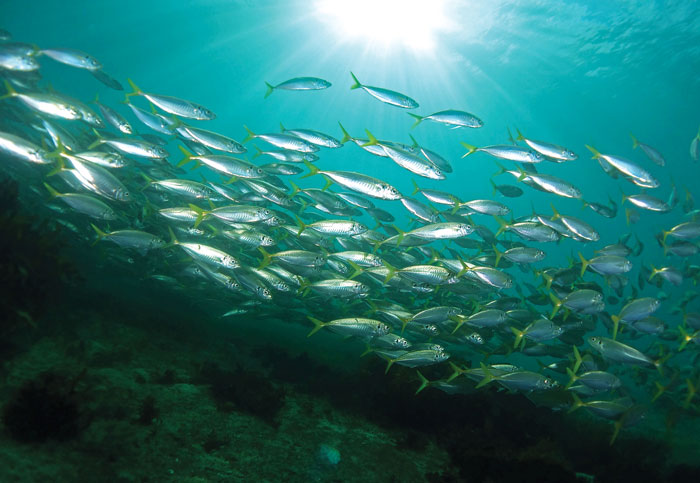
Why forage fish love artificial reefs
Food and safety are the key factors that draw more small foraging fish to artificial reefs than to natural reefs in the Sydney region. Researchers from the University of New South Wales (UNSW) have identified these drawcards in a comparison of five natural and three artificial reefs in Sydney. They found the vertical structures of artificial reefs allowed smaller fish to spread out and feed much higher above the seafloor than they can on natural reefs, while still remaining close to the safety of a physical structure. The fish also had access to more plankton to feed on than they would on a low-lying natural reef; good quantities of plankton are delivered higher in the water column by the East Australian Current. The greater number of small fish has flow-on benefits for their predators, such as the Bluespotted Flathead (Platycephalus caeruleopunctatus), one of NSW’s most iconic commercial and recreational fish. NSW has eight artificial reefs, at South Head in Sydney, Port Hacking in South Sydney, Shoalhaven, Port Macquarie, Merimbula, Newcastle, Wollongong and Tweed Heads. The study, which has been published in Marine Ecology Progress Series, has implications for future reef design and recreational fishing initiatives.
Fish names changes
Genetic testing has led to the reclassification of some well-known seafood species and changes to their scientific names, which have been updated in the Australian Fish Names Standard. These include Pacific Oysters, which have changed from Crassostrea gigas to Magallana gigas, and Striped Marlin, which has changed from Tetrapturus audax to Kajikia audax.
The scientific name for Baby Octopuses has also changed from Octopus aegina and Octopus sp. A to Amphioctopus spp. Periwinkles will change from Trochidae, Margaritidae, Solariellidae and Tegulidae spp. to Littorinidae, Neritidae, Trochidae, Margaritidae, Solariellidae, Tegulidae, Liotiidae, Areneidae and Turbinidae – these are families of undifferentiated genera (groups of related species), hence no italics.
New additions being considered for inclusion in the Fish Names Standard are Akoya Pearl Oyster (Pinctada imbricata fucata) and Blacklip Rock Oyster (Saccostrea echinata).
Visit the Seafood Standards website to request a change to a fish name, or an addition to the database.
You can also find the approved common and scientific names on the searchable fish names database at fishnames.
To receive regular updates about the Fish Names Standard or Aquatic Plant Names Standard, email FNC@frdc.com.au or APNC@frdc.com.au, respectively.
Plastic dominates beach rubbish
Ten years of data from citizen scientists have contributed to a University of New South Wales (UNSW) study that found plastic makes up to 84 per cent of all rubbish found across Australian beaches.
The UNSW-led study is based on one of the largest marine debris databases in the Southern Hemisphere, the Australian Marine Debris Initiative (AMDI), which was set up by the not-for-profit Tangaroa Blue Foundation in 2004. More than 2000 organisations and 150,000 citizen scientists have participated in the AMDI by sorting and tallying the marine debris they have collected. The study filtered and analysed 10 years of the AMDI Database and created a national map of patterns in marine debris. It found almost half of all debris could be related to land-based sources, such as litter and dumping on land, and seven per cent to dumping at sea.
But 42 per cent of the debris could not be related definitively to a source due to the debris breaking down into small fragments. The researchers say this highlights the legacy of plastic in our environment: microplastics formed by the plastic continually fragmenting into smaller pieces.
Results were collated nationally and also by the six ‘bioregions’ used to manage oceans and coasts: North (Northern Territory to Cape York); North-west (Western Australia); South-west (lower WA and South Australia); South-east (including Victoria and Tasmania); Temperate East (mainly New South Wales); and Coral Sea/Great Barrier Reef Marine Park (Queensland).
The South-east and South-west regions had larger numbers of fishing items, and the proportion of cigarette butts in the Temperate East was three times the national average, which shows a problem with local litter, the study suggested.
The findings have been published in the journal Science of The Total Environment.
Word-wise
The total allowable catch (TAC) refers to the combined catch permitted in a fishery by all sectors: commercial, Indigenous and recreational.
The total allowable commercial catch (TACC) refers only to the share of the permitted catch that commercial fishers are allowed to harvest.
Quota is the volume of a species that can be harvested in a fishery, which may equate to the TAC for the whole fishery, or the TACC for the commercial sector, or for other specified stakeholders, such as a recreational fishing, or cultural fishing quota.
An individual transferable quota (ITQ) is the share of catch owned by individual fishers or businesses, and it can be bought, sold or leased.
TACs, TACCs and quotas are generally measured in tonnes.
A bag limit is the maximum number of fish or animals of a particular species (or species group) that a recreational fisher can retain on a given calendar day.





